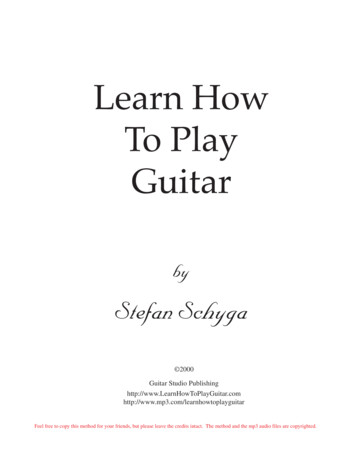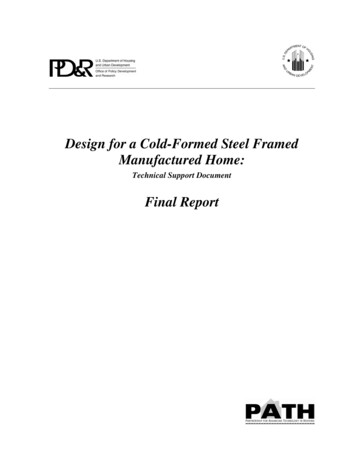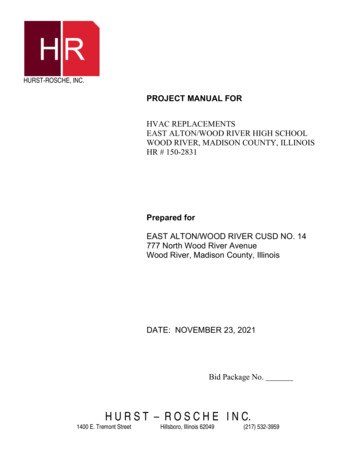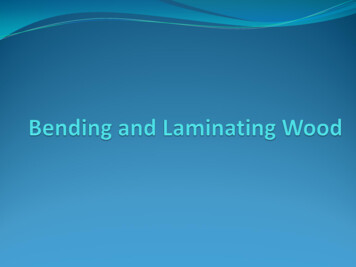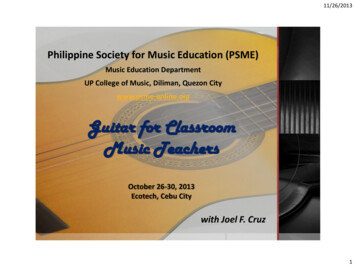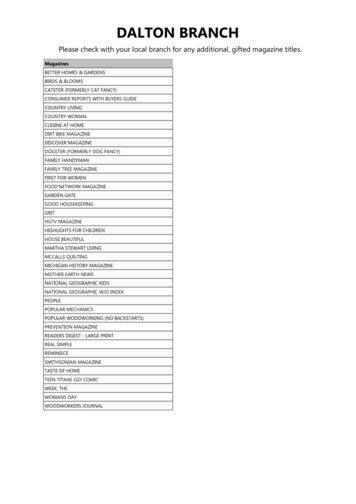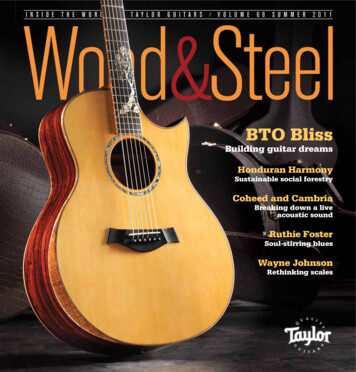
Transcription
BTO BlissBuilding guitar dreamsHonduran HarmonySustainable social forestryCoheed and CambriaBreaking down a liveacoustic soundRuthie FosterSoul-stirring bluesWayne JohnsonRethinking scales
www.taylorguitars.com2LettersTommy ShawGets his bluegrass onSpring LimitedsMacassar 12-Fret & T3Walnut Double FeatureAll-Mahogany RootsCenter. Thank you for thinking outsidethe box and creating the most amazingacoustic/electric guitar that doesn’trequire a world-class concert hall tosound world-class!Bob FischerOcala, FLDoyle Dykes & the LightsInside his new bookExpressionismThe art of the ESNAMMNotesNew York State of MindAfter reading Jim Kirlin’s article,“Freedom of Expression,” in your springissue, I was reminded of the springof 1971, when I played guitar for a60-voice touring choir from Concordia College, New York. At the variousvenues it was always a challenge (ifnot a nightmare) to amplify my MartinD-35. The tour ended with a concert atLincoln Center’s Alice Tully Hall, wherethe acoustics were so amazing that myguitar did not have to be amped. Foryears I’ve searched in vain for that pure,natural acoustic guitar sound, but thatwas a once-in-a-lifetime experience — orso I thought.Those of us who have been aroundfor a while know that there have beenmany failed efforts to amp acousticguitars, from tinny, scratchy setups andgimmicks to sad situations where theinstrument was overwhelmed or justmade to sound like an electric guitar.Four years ago, Sound ExchangeMusic became an official distributor ofTaylor Guitars. The owner and the workers at the shop were impressed withthe new Taylors and enlightened mewith their new find. My wife and I purchased our son an 814ce. He and I useit along with a 312ce in locations fromsmall rooms with low ceilings to largechurch sanctuaries. The combinationof the tonewoods and the ExpressionSystem is by far the best natural soundfor the performer and the audience. Weoften say that the guitar does not reallysound amped — it just “emanates.” Itis virtually impossible to tell where theactual instrumental sound ends and theelectronics take over. Additionally, whenplaying in any sort of group, the Taylorscut through and are heard clearly andnaturally.It has been 40 years since thatchoir concert in NYC, but every time Ihear or play one of the Taylors, it takesme back to that night in LincolnHarmonically ChallengedI believe there is a mistake on page27 of Wood&Steel (“The Irrational Fretboard,” Vol 67/Spring 2011). The finalG note in Example 13 should be on thefourth (D) string, fifth fret instead of thethird (G) string, fifth fret, which as weknow is a C note. Seasoned musicianswill clearly know this, but it may confuse [other] readers. On another note, Igreatly enjoyed the Tommy Shaw articleand the insightful fellow Canadian’sletter in “Ask Bob” concerning the converted bookcase/guitar storage cabinet.Larry GarnettOttawa, CanadaEd. Note: Good catch, Larry. Aftergoing to press we discovered that aportion of Shawn Persinger’s musicnotation had dropped out when imported into a different software program.Besides the notation not showing up inthe staff, the notes in Ex. 13 are natural harmonics, and the diamond symbols denoting harmonics didn’t displayin the tablature. So, the fifth fret, thirdstring played as a harmonic is actuallya G harmonic. The lesson’s completenotation is available in the online version of the issue at taylorguitars.com.Sorry for the confusion.Happy HubbyMy husband has always wanteda 12-string guitar — more specificallya Taylor 12. In 2006 he found a 355and fell in love. They have the samebirthday, so I bought it for him. What’sa little credit card debt compared to ahusband’s happiness? He played nonstop for about three weeks, and thenannounced, “This is a great guitar, but ifI want to play Leo Kottke tunes, I haveto have the Leo Kottke model.” I lethim explain the whys and whereforesfor a year, and bought him an LKSM.He experimented with odd tuningsnon-stop for about three weeks andthen announced, “This is a great guitar,but the 6-string would be nice, too!” Ilet him try to convince me of the needfor the 6-string for another year, andbought the LKSM6. He was the happiest man on earth, or so I thought.In 2009, we saw Leo Kottke perform, and Mark took his own guitarwith him to the concert. Afterward, Mr.Kottke came out on stage to meet hisloyal fans. Mark handed him his belovedguitar for an autograph. Leo held it,strummed it, recognized the open E-flattuning, and sat down on the edge ofthe stage and played! He and Markhad a conversation about strings, bonenuts, etc., before getting an autographon the back of the headstock. NOW Ihave the happiest husband on earth! Orso I thought. There is something newyou call an 8-string baritone. Thanksa lot, Bob! I think I’m going make himwait a year.Andrea EckhartWorthy of ByrdI purchased the NS24ce a year ago.This guitar is a joy to hold and makesfingerpicking an ease. I usually play jazzand Latin music, and this instrumentworks fine in these genres. I’m a bigfan of the late, great Charlie Byrd, who,along with Stan Getz, exposed thebossa nova and Latin rhythms to theAmerican public. Charlie sometimescomplained about just not being able tofind “that” sound on his classical backin the late sixties and early seventies. Iknow if he were alive today he’d have aTaylor [nylon-string] in his hands.Ed BaranAcoustic RevivalI just received my 1990 Dan CrarySignature Model guitar back from RyanMcMullen’s team in the Service department. I had sent the guitar back for yourRevive package. Holy mackerel! It’slike having a brand-new guitar with thevoice of a well-played friend. I wouldhighly recommend the Revive packageto anyone who has a well-played Taylorand is in need of a tune-up. My guitarhad experienced some rough humiditychanges prior to my ownership, whichleft the guitar with a cracked and liftedbridge, a dip where the fingerboardmeets the body, pretty worn frets, anda need for a new nut and saddle. Theguitar came back with every repairexpertly provided. It rings like a bell andprojects like a cannon — a guitarist’sdream. Thank you, Ryan and your team.Chuck LokerBlues to OrderIt has been two weeks since Ireceived my Taylor BTO 12-Fret. Wow,what a fantastic guitar! It is everythingI had imagined and more. I asked youto build me a blues guitar, and that isexactly what you did. The workmanshipis nothing short of artistry in wood. Ican’t take my eyes off of it, and it playslike a dream. If it is true that guitarssound better with age, I can only imagine how this one will sound as we growolder together. Thanks for a wonderfulinstrument.Tom RusieckiPort Richey, FLCheatin’ & Repeatin’I had been yearning for a T5 eversince they came out, but my wife hassteadfastly threatened to leave if Ibought one more guitar. After all, shereasoned, six (3 Taylors) are more thanenough: “You can only play one at atime.”I demanded, cajoled, wheedled,begged and whined to no avail. FinallyI began singing “Your Cheatin’ Heart”at 3 a.m., refusing to quit until sheagreed to the T5. She finally relentedon the 34th rendition, and not only didshe agree, she offered to buy it for mybirthday if only I would quit singing! Webought it from Randy at Quality Guitarsin Spring Hill, Florida. He let me playas many different T5s as he had foras long as I wanted, and worked veryhard to make sure I was totally satisfiedwith my choice. I would highly recommend Quality Guitars to anyone lookingto purchase a new guitar. I can’t sayenough about what a cool guitar the T5is. It is everything that I hoped it wouldbe and more.Ben GilbertPassion PlayI just wanted to let you know whymy Taylor is so important to me. WhenI was 16, my mom died after a two-yearrun with brain cancer. I was extremelyclose to her, and one of the greatestgifts she gave me was passion (and talent) for music. She was a lifelong pianist, guitarist and singer, and she supported my musical efforts to the fullest,buying me just about any instrument Idecided I wanted to learn. When shepassed, I was still just starting out withguitar, but I took it seriously. When Iwas 18, I received life insurance money,and after considering where my passion lies, I purchased a Taylor 814ce.As far as the guitar goes, I could not behappier. Its beautifully balanced tone,intonation, and playability are superior.I’m now 22, and I can already hear itopening up even more after obsessivelyplaying it for three years! The coolthing for me, though, is that when I playthat guitar — my first real and lifelongguitar — I think of my mom, who essentially enabled me to have it. Though I’llalways miss her, she left me with anappreciation for fine instruments andwell-made music. Since I bought the814ce, I’ve also picked up the NS72ceafter watching YouTube videos of JasonMraz walking around France playingone. That guitar is gorgeous, and it’sthe perfect complement to the 814ceat shows when I want an alternativeto steel strings. Thank you for buildingfantastic guitars and for being an honest, ground-up company (I’m currentlyhalfway through Bob Taylor’s GuitarLessons). Thanks to you, I have a guitarthat brings back fond memories of thewoman who helped me realize my passion.Kevin CastilloSeaworthy SoundI just returned from 2-1/2 weekson an expedition-type cruise along theAntarctica Peninsula. Just before leaving, I decided to find a Baby Taylorto take and to play while on the ship.A longtime Taylor player, I envisionedbringing a low-cost, decent-soundingbut compact guitar to entertain myselfand maybe others if the opportunityarose. I settled on a GS Mini becauseof its higher-quality sound, even thoughit’s a bit larger than a Baby. The Minitraveled beautifully in its sturdy, softcase and strapped right onto my rolling duffel bag (I luckily avoided havingto check it). After crossing the stormyDrake Passage, the seas calmed downand I pulled out the guitar and sangand played that night in the Observation Deck/Bar. Long story short, itwas a hit, and I played many eveningsthroughout the awesome journey. TheGS Mini has an amazing volume and adecent tone for such a lightweight guitar. I tend to play a guitar hard to keepa strong beat and use syncopated,percussive sounds, and the Mini tookmy hard-driving strumming well. Further,I tune down a half step and then usea capo in various positions. Amazingly,there was no string buzz. Bringing theMini along helped make the trip thatmuch better for me and for many others. Thanks for another great guitardesign!Kelly RogersWe’d like tohear from youSend your e-mails to:pr@taylorguitars.com
3Volume 68Summer 2011Find us on Facebook. Subscribe on YouTube. Follow us on Twitter: twitter.com/taylorguitarsFeatures6 Breaking the MoldGrammy winner and Road Show troubadour Wayne Johnson will help youescape the oppression of scales, forget your muscle memory, and boost yourfretboard creativity.On the Cover18 BTO BeautiesOur Build to Order programcontinues to bring your inspirationto life. Here are a few samples ofour latest offerings.Cover photo:Cocobolo/Adirondack spruceGS with aged toner top,koa binding and armrest,green heart abalone rosette,abalone/black oyster/agoyatree fretboard inlay, andFlorentine cutaway69 Guitar SpotlightWe give you the SolidBody Standard in Borrego Red.12 The Wood&Steel Interview: Ruthie FosterShe’s earned raves from Al Kooper, props from Jorma Kaukonen, and backedWarren Haynes on vocals. Award-winning blues artist Ruthie Foster traces herroots-rich musical path.11216 Acoustic Case Study: Coheed and the CrewOur own Rob Magargal was enlisted to help prog-rockers Coheed and Cambriatake their live acoustic tone to the next level. Armed with a few secret weapons,he knew just what to do.20 Mahogany Branches OutTen years of Taylor investment in sustainable forestry in Honduras has helpeda model program spread to other communities.Departments9202 Letters4 Kurt’s Corner5 BobSpeak5102427Editor’s NoteAsk BobSoundingsTaylor Notes28 WorldView31 Calendar32 TaylorWare
www.taylorguitars.com4Volume 68Summer 2011Publisher / Taylor-Listug, Inc.Produced by the Taylor Guitars Marketing DepartmentVice President of Sales & Marketing / Brian SwerdfegerDirector of Brand Marketing / Jonathan ForstotEditor / Jim KirlinSenior Art Director / Cory SheehanArt Director / Rita Funk-HoffmanGraphic Designer / Angie Stamos-GuerraPhotographer / Tim WhitehouseContributorsJonathan Forstot / David Hosler / David Kaye / Kurt Listug / Shawn PersingerShane Roeschlein / Bob Taylor / Corey Witt / Glen Wolff / Chalise ZolezziKurt’s CornerCollection NoticeWith the Internet, it’s easy to doresearch or share information or opinions with others. Many of us spendtime on websites dedicated to ourhobbies or interests, including on userforums. Some of you probably spendtime regularly reading or contributingto guitar forums. Even though I’ve beenaround guitars since 1964 and in thebusiness since 1973, I don’t spendmy spare time on guitar forums; carsare much more of a hobby for me. Sothe forums I’m usually on are Teamspeed, 6 Speed Online, Rennspeed,Ferrari Chat, or recently The Sambaand IH8Mud. I’ve noticed a frequenttheme, especially on the sports carforums, centering on the future valueor collectability of new models. There’sfrequently a lot of speculation abouta car that’s likely to become a future“collectable.” I’m sure some of thatemotion has to do with the desire tohave something unique and special,but probably a lot of it has to do withmaking a smart purchase, hoping thevehicle will retain or possibly evenincrease its value.I think a lot of factors enter in to thefuture value or collectability of a car ora guitar, such as the popularity of thebrand; the quality and uniqueness ofthe product; whether a car has a racing pedigree or a guitar is used by apopular artist; how many are made andthe relative scarcity; whether it brokenew ground for the brand; whether itrepresented the end of an era for thebrand; and so on. However, I think thebiggest factor is ultimately what marketforces will decide over time, and this islargely unpredictable.Several of us at Taylor had VWbuses when we were younger. Theywere part of a young person’s lifestyle,plus we grew up here in SouthernCalifornia, where buses were part ofthe beach culture. They were simple,affordable, fairly reliable, and easy tofix. We sold them when we were a littleolder and done with them, for maybe afew thousand dollars. Who would havethought then that a clean, respectablepre-1968 bus could be worth as muchor more as a brand new vehicle today?Both Porsche and Ferrari havemade very special cars in very limitednumbers, and a few of these have donevery well value-wise, while the majority of them have depreciated like mostmodels they’ve produced. A buyer fora car like this should be prepared tobuy the car for the pleasure of drivingand owning it, but shouldn’t justify thepurchase by thinking it will hold itsvalue or perhaps even appreciate; itisn’t likely to happen. Or, the buyer mayget lucky if they keep it for a very longtime and the market decides it was oneof those rare special cars and bids thevalue up.I really don’t think the manufacturercan determine which of their productsare destined to be a future collectable.The car manufacturers can’t do it, andneither can the guitar makers. All theguitars that have been produced overall the decades have been some combination of creativity and the need tocome up with something to make andsell. Occasionally the economic needto invent a guitar model to have something new to sell has resulted in a guitar the market decades later deemedspecial and collectable. That guitarstarted its life as likely just anothershot at paying the bills and hopefullysurviving to be able to continue makingguitars. That guitar then got lucky whenit was deemed special and uniqueenough to become collectable andincrease in value. The market did that,and it took time, and it took unpredictable changes in social and musicaltrends to bring this about. Keep thisin mind the next time you see guitars(or cars) being marketed as future collectables!I know I’ll lose money on my sportscars, so I just drive them and enjoythem. My buses, on the other hand,have stood the test of time and gainedground in value. But, as they say, pastperformance is no guarantee of futureresults. — Kurt Listug, CEOTechnical AdvisorsEd Granero / David Hosler / Gerry Kowalski / Andy Lund / Rob MagargalMike Mosley / Brian Swerdfeger / Bob Taylor / Chris Wellons / Glen WolffContributing PhotographersRita Funk-Hoffman / David Kaye / Steve ParrCirculationKatrina HorstmanPrinting / DistributionCourier Graphics / CEREUS - Phoenix 2011 Taylor Guitars. 100 SERIES, 200 SERIES, 300 SERIES, 400 SERIES, 500 SERIES, 600 SERIES,700 SERIES, 800 SERIES, 900 SERIES, Baby Taylor, Big Baby, Bridge Design, Doyle Dykes SignatureModel, Dynamic Body Sensor, Expression System, GALLERY Series, K4, Liberty Tree, Peghead Design,Pickguard Design, PRESENTATION Series, Quality Taylor Guitars, Guitars and Cases & Design, T5, T5(Stylized), Taylor, Taylor (Stylized), Taylor ES, Taylor Expression System, TAYLOR GUITARS Taylor Guitars K4,Taylor K4, TAYLOR QUALITY GUITARS and Design, TAYLORWARE, and WOOD&STEEL are registeredtrademarks of the company. Balanced Breakout, Dynamic String Sensor, ES Blue, ES-Go, Grand Symphony,GS, GS Mini, GS SERIES, T5 Thinline Fiveway, Taylor Acoustic Electronics, ES-T, Thinline (T5) Fiveway, T3,T3/B, T-Lock and V-Cable are trademarks of the company. Patents pending.2011 Taylor Factory Tours & Vacation DatesA free, guided tour of the Taylor Guitars factory is given every Mondaythrough Friday at 1 p.m. (excluding holidays). No advance reservations arenecessary. Simply check-in at our reception desk in the lobby of our mainbuilding by 1 p.m. We ask that large groups (more than 10) call us in advanceat (619) 258-1207.While not physically demanding, the tour does include a fair amount ofwalking. Due to the technical nature, the tour may not be suitable for smallchildren. The tour lasts approximately one hour and 15 minutes and departsfrom the main building at 1980 Gillespie Way in El Cajon, California.Please take note of the weekday exceptions below. For more information, including directions to the factory, please visit taylorguitars.com/contact/factorytour.We look forward to seeing you!Holiday ClosuresMonday, September 5(Labor Day)Friday, October 14(Taylor Guitars Anniversary)Thursday-Friday, November 24-25(Thanksgiving Holiday)
5Editor’s NoteFriends Far and WideBobSpeakStraight from the SourceLately I’ve been traveling more,working on wood legality issues andhelping to ensure that Taylor Guitars isin good standing when it comes to ourpractices and the practices of thosewho cut our wood. In this issue, youcan read of my recent trip to Hondurasto visit the three communities that cutmahogany for us and to celebrate the10-year anniversary of the firststories up that I could no longer hearthe TV. I went outside and watchedin amazement. I’ve seen heavy rainbefore, but not this.The next day it came down likethat again, after we’d driven far into aforested area. While stopped for lunch,we watched from inside a thatchedroof dining room as rain dropped inbuckets. My PVC-coated duffel bag,Sometimes I wish I could take eachand every customer to the sources ofour wood so they could see for themselves what people do to get it out.community, Copen. The article will giveyou the meaty stuff, about the woodand the elegant way it’s extracted, leaving the forest in good shape.I want to talk about the rain.The first rain came while I was inmy hotel room the first night. This wasa two-story, Travelodge-type hotel, withmultiple buildings and outside accessto each room. I was checked in, waitingto meet for dinner, lying on the bed andlistening to the TV when the nightly rainbegan to fall.Within minutes it was pouring, andyou could hear it outside running offthe roof. Then harder, and even harder,until it was so noisy on the tile roof twowith all my clothes and sleeping gear,was in the exposed truck bed. Thethought never occurred to me to takemy bag out of the back because I thinkof it as being waterproof. Yeah, right!Southern California waterproof. Let’sjust say I had to pour water out of it.By the time a couple more dayshad passed, I was outside on horseback in the rain, working my way tomore remote communities. By then Iwas like, “Who cares? So I get wet.”And I did, and then I got dry, and thenwet and then dry. I adapted. You wouldhave, too. It made the whole experience richer. You can see why treesgrow there. The daily rain was epic,and this was the dry season. In the wetseason no work occurs in the forestbecause, even for the locals, it’s justtoo much.Life in these areas is hard and notat all what most of us are used to. It isimpressive how much work is done toget guitar wood from the forest to theworkbench. Sometimes I wish I couldtake each and every customer to thesources of our wood so they could seefor themselves what people do to get itout. Whenever I do that, people alwaysmake comments like, “Gosh, I hadno idea! I will never complain about astreak in my guitar top again!”Sometimes we get so far removedfrom the products we buy: our clothes,our food, our cars, and, yes, our guitars. I can do the same thing when itcomes to raw materials. That’s whyit’s always good for me to go visit theplaces and the people who make thewood possible. I jokingly tell peoplethat “wood doesn’t grow on trees,”meaning it’s not so easy to obtain,and when you go to the source it suredrives that home. I hope the article inthis issue gives you a little glimpse ofthe source for the wood on your guitar,along with the people who toil to makeit available to us. — Bob Taylor, PresidentIt’s official: Taylor’s Facebook community has passed the75,000-member mark. The growth of the community has been exciting towatch over the past few years, as people from all walks of life and everynook of the world have brought their unique voices to the conversation.From artist recommendations to homespun performance videos tophotos and personal stories, people love having a place to talk aboutmusic and their guitars, and for those of us who work at Taylor, it’sgratifying to be a part of it all. As I’ve told guests who tour the factory, Ifeel fortunate to arrive at work each day knowing that we’ll be shippingout a fresh batch of guitars that are destined to be instruments of joy,comfort and inspiration to another group of people.The personal accounts that Taylor owners share underscore howprofound an influence music can be in life. We recently posted aquestion to our Facebook friends soliciting anecdotes from those whohave used their Taylors as a tool of music therapy for people with injuriesor other disabilities, and the replies were powerful. People wrote ofplaying for patients with cancer, soldiers suffering with post traumaticstress disorder, autistic and learning-challenged kids, recovering addicts,nursing home residents, and more. What was especially poignant was toread how meaningful these experiences were not just for the listeners butalso for the players themselves. We plan to explore this theme in greaterdetail in future issues.Facebook is just one example of the value we place on personalconnections. This issue, you’ll read about the sourcing relationshipswe’ve forged directly with remote Honduran communities that supplywood we use for our necks. In Taylor Notes we relay a pair of accountsfrom our spring season of Road Shows, including an educational eventwith the general public at the Orlando Science Center and a gathering inJoplin, Missouri only a few weeks after the community was ravaged by atornado. In Soundings we report on a recent get-together with some ofNashville’s leading players to share some new prototypes and elicit theirfeedback. WorldView spotlights our reinvigorated customer outreach inEurope. Our story on Coheed and Cambria highlights our commitment toworking with artists and their sound crews to help them sound their best.And in late July and all of August, we’ll be scattering across the U.S. fora series of “Find Your Fit” special events at dealers (see page 30), wherewe’ll be offering one-on-one consultations with people to answer anyquestions they have about finding the right guitar.All of these connections may start because of a guitar, but that’soften just the beginning of something much more, something that has thepower to resonate deeply with many others. Thank you for sharing yourstories, and please keep them coming. We promise to do the same.— Jim KirlinOnlineRead this and other back issues of Wood&Steel attaylorguitars.com under “Resources.”
BreakingthePracticing scales builds muscle memory butcan leave you stuck in a rut. Wayne JohnsonJohnsonshows you how to break free to become amore expressive player.By Wayne JohnsonMold
7Ed. Note: We’re pleased to welcomeWayne Johnson, a Grammy-winningguitarist and Taylor Road Show product specialist, back to the pages ofWood&Steel as a regular contributor.In addition to writing instructionalpieces, Wayne will also be presentingonline video lessons, some as W&Scompanion pieces and others on anew lesson page we’ve set up on theTaylor website. The lesson page willencourage interaction between Taylorplayers and Wayne, and allow him tofield questions and share additionalguitar-playing tips.If I were to ask you to play me aC major scale, what note wouldyou start on? The logical answer,of course, is C. It’s the tonic, the homebase, the reason the scale is named C.Now let me ask you this: Can you playme a C scale without starting on C? Orrather, can you play me the notes thatbelong to the C scale without startingon C? Why is this so difficult?Well, as you may have read lastissue in Shawn Persinger’s article, “TheIrrational Fretboard,” the guitar fretboardis not logical. I can show a four-yearold the C scale on a piano, and withina few minutes he or she could playthat scale up, down and randomly. It iscompletely visual. On a guitar, it wouldprobably take that same four-year-old acouple of weeks to learn a C scale —and that’s just in one position. Unlikethe piano, all fingering on the guitarchanges as you go up the fretboard.Learning the C scale in seven positions(one position for each of the sevenscale tones) requires that you learnseven different scale forms.Because the guitar is so different inthis respect, we resort to memorizationto learn it. We practice the same thingover and over again until our fingers“get it.” The problem with muscle memory is that we play like we practice, andwe play what we practice. If your entireguitar methodology is muscle memory,then your creative experience will be nil.How many times have you tried to playsomething that turned out to be mucheasier if you started somewhere elsefirst? Hence, the C scale is easy, aslong as you start on C!Don’t get me wrong — memorization is a useful technique for learninghow to play guitar. Because of it, somethings are actually easier on guitar,such as transposition. You can take asong in the key of A and easily play it inB by thinking “up two frets” for everything. Try this on the piano! You’re notthinking about the harmonic relationships in order to play this song in B.You’re using memorization skills. Well,I’m here to tell you that this is all good.We need to take advantage of the easier elements in learning this instrumentto make up for the more difficult ones.My goal here is to show you adifferent type of visualization on theguitar, one that will help you learn andrecognize shapes, groupings, intervalsand symmetry. Through this visualizationprocess and the practicing of scalesand passages in a more linear (horizontal) manner, and by concentratingon single-string and random scale-notepractice, you’ll start to wean yourselfoff many of the memorization crutchesthat block your creative expression. Thisprocess will not only help train your ear,it will also greatly improve your melodicdevelopment.A couple of notes before we divein. First, this is a fretboard lesson (lefthand for most), so you may use yourpicking hand in any manner you wish —picks or fingers. Also, I’d like to say afew words about positions and scaleforms. Basically, a position number isthe fret number where your index (first)finger (on your fretboard hand) rests atany given time. For example, in position5, your index finger would fall alongthe fifth fret. Following naturally up thefretboard, your second finger rests onthe sixth fret, third finger on the seventhfret and fourth finger on the eighth fret.The only alteration to this formula isthat your index finger might reach onefret below its home position fret, andyour fourth finger might reach aboveits home position fret at any time ifneeded, without it actually signifying aposition change. These are just momentary stretches.Scale form numbers have nothingto do with position numbers. Positionnumbers tell you what frets you’regoing to be centered around, whereasscale form numbers tell you what shapeyou’re going to play, in that position.There are different methods of learning scale forms. I like the simplicity ofusing seven scale forms — one for eachdegree of the scale. This simply meansthat in scale form 5, for instance, yourlowest note or first finger would bestarting on the fifth note of the scale.Scale form 3 would start on the thirdnote of the scale and so on. This willbecome more obvious as we get into itmore. Now, let’s get started!Fig. 1 is the C major scale in openposition. It is in open position becauseit incorporates open (unfretted) stringsto complete the scale. In open position,your first finger would be located overthe nut, which we’ll call fret 0. Fret 0, oropen E, is the third note of the C scale,so this will be scale form 3. Notice thatthe inside one-octave C scale is darkened. The orange notes are extensionsof the C scale below and above theinside one-octave scale. The tonic orC notes have a circle around them. Allof these notes
Acoustic Revival I just received my 1990 Dan Crary Signature Model guitar back from Ryan McMullen’s team in the Service depart-ment. I had sent the guitar back for your Revive package. Holy mackerel! It’s like having a brand-new guitar with the voice of a well-played friend. I would to an
